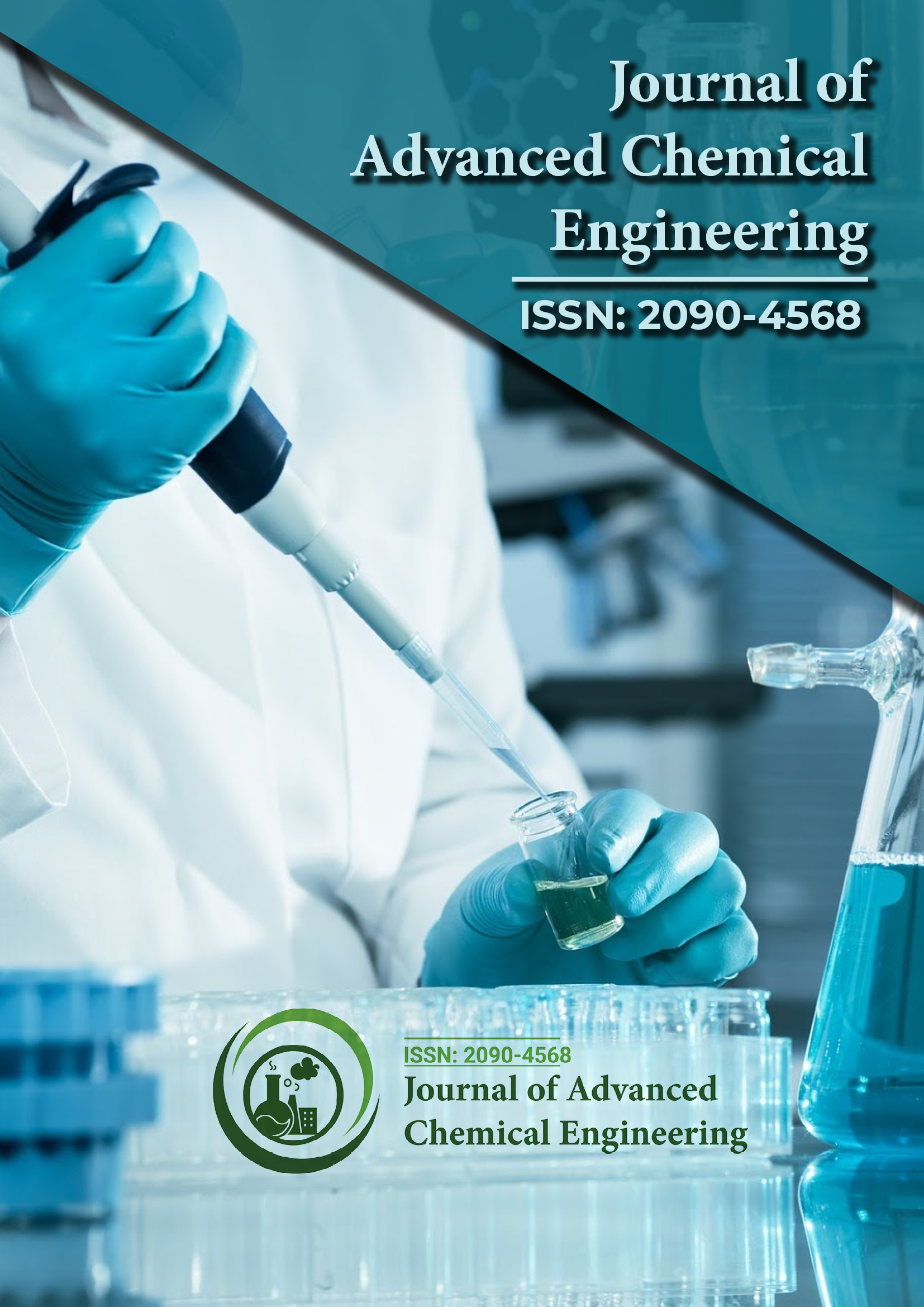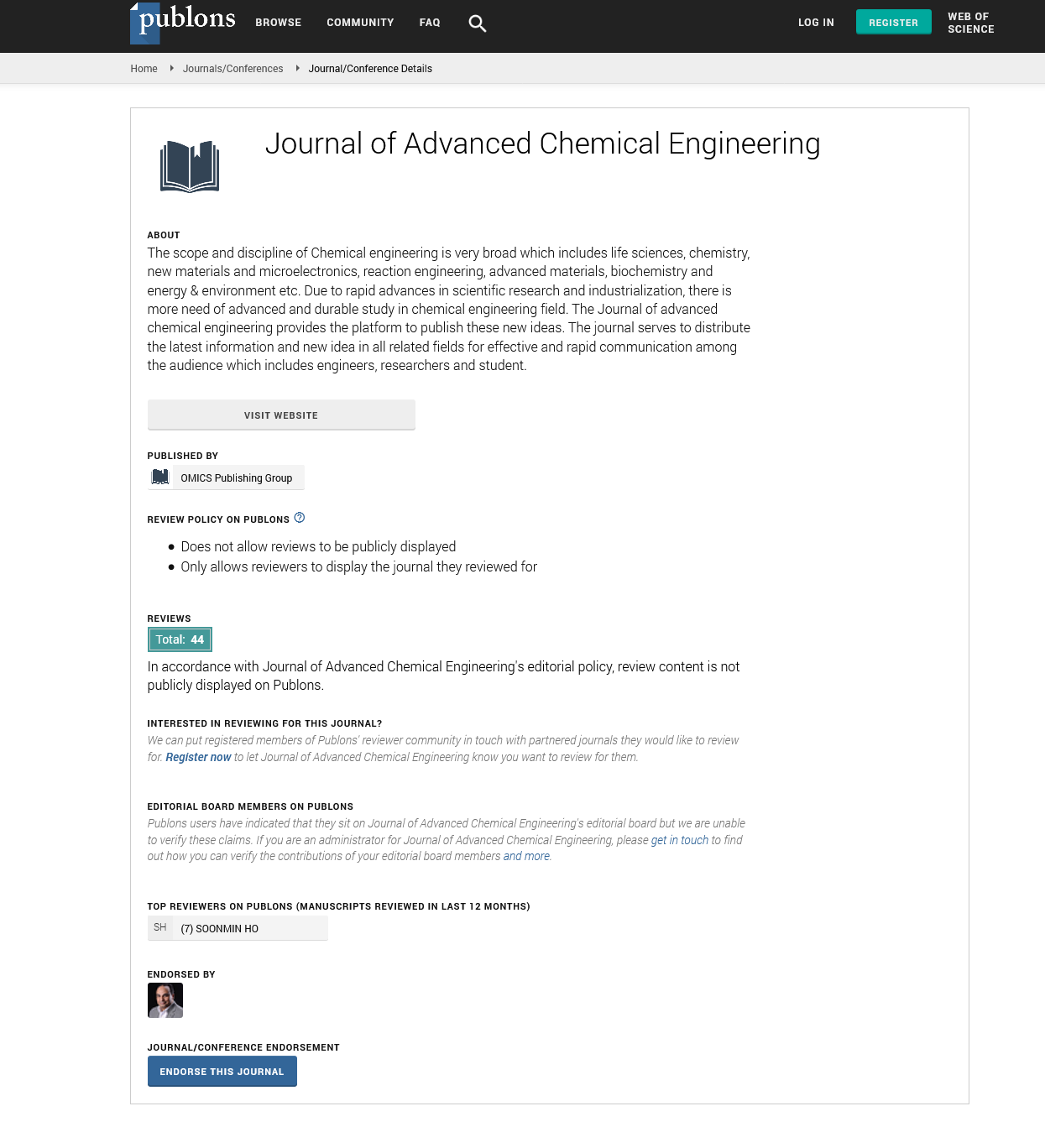Indexed In
- Open J Gate
- Genamics JournalSeek
- Smithers Rapra
- RefSeek
- Directory of Research Journal Indexing (DRJI)
- Hamdard University
- EBSCO A-Z
- OCLC- WorldCat
- Scholarsteer
- Publons
- Geneva Foundation for Medical Education and Research
- Google Scholar
Useful Links
Share This Page
Journal Flyer

Open Access Journals
- Agri and Aquaculture
- Biochemistry
- Bioinformatics & Systems Biology
- Business & Management
- Chemistry
- Clinical Sciences
- Engineering
- Food & Nutrition
- General Science
- Genetics & Molecular Biology
- Immunology & Microbiology
- Medical Sciences
- Neuroscience & Psychology
- Nursing & Health Care
- Pharmaceutical Sciences
Perspective - (2025) Volume 15, Issue 1
Reactive Distillation as a Process Intensification Technique in Fine Chemical Synthesis
Amina El-Fahmy*Received: 03-Mar-2025, Manuscript No. ACE-25-29153; Editor assigned: 05-Mar-2025, Pre QC No. ACE-25-29153 (PQ); Reviewed: 19-Mar-2025, QC No. ACE-25-29153; Revised: 26-Mar-2025, Manuscript No. ACE-25-29153 (R); Published: 02-Apr-2025, DOI: 10.35248/2090-4568.25.15.357
Description
Reactive distillation has emerged as a powerful technique in the field of process intensification, offering a strategic advantage in the synthesis of fine and specialty chemicals. It uniquely combines chemical reaction and separation into a single unit operation, leading to lower energy consumption, reduced equipment size, and simplified process flowsheets. This integration not only makes the process economically attractive but also environmentally sustainable, which is particularly important in today’s regulatory and energy-constrained manufacturing landscape.
Traditional chemical synthesis typically involves multiple steps, including reaction, separation, and purification, each requiring distinct equipment and utilities. These segmented operations not only increase capital investment but also incur additional energy usage and processing time. Reactive distillation eliminates the need for separate reactor and distillation columns, offering a continuous, efficient method for equilibrium-limited reactions by shifting the reaction equilibrium towards product formation through in situ removal of volatile products.
One of the most widely studied applications of reactive distillation is the production of methyl acetate from acetic acid and methanol. In a conventional setup, this equilibrium-limited esterification requires excess reactants and complex separation sequences. However, by employing reactive distillation, methyl acetate is continuously removed from the reaction zone, driving the equilibrium forward and enhancing the yield significantly. Moreover, heat integration within the column reduces the need for external heating or cooling sources.
The selection of catalyst and its placement within the column are critical design considerations. Solid acid catalysts such as Amberlyst-15 and zeolites are commonly packed into trays or structured packing within the reactive zone. This allows for efficient contact between the vapor, liquid, and catalytic surfaces, maximizing reaction rates and ensuring consistent conversion. Research is ongoing into the development of novel catalysts with higher activity, thermal stability, and resistance to fouling, especially for reactions involving heavier molecules or trace impurities.
A key challenge in reactive distillation lies in the simultaneous optimization of reaction kinetics and mass transfer. The operating conditions must be meticulously controlled to balance the rate of reaction with the separation efficiency of the column. This involves careful design of the column internals, reflux ratio, pressure profile, and feed stage locations. Computational modeling and simulation tools such as Aspen Plus and PRO/II are extensively used to predict the behavior of reactive distillation systems and guide the scale-up process.
Beyond esters, reactive distillation is increasingly being applied in the production of ethers, aldehydes, and specialty solvents. The synthesis of tert-butyl methyl ether (MTBE), an important fuel additive, is a classic industrial-scale example of this technology. The reaction between methanol and isobutylene is equilibrium-limited and exothermic, and reactive distillation provides both the necessary heat management and efficient separation in a single step.
Energy savings achieved through this method are substantial. Since reactive heat and separation requirements often overlap, the energy required for vaporization in the reaction zone is partially supplied by the reaction heat itself. This inherent integration reduces utility costs and enhances the thermodynamic efficiency of the system. Moreover, the reduction in the number of equipment units leads to lower maintenance costs and a smaller physical footprint for the plant.
However, there are certain limitations and risks associated with reactive distillation. Temperature sensitivity of catalysts, operational flexibility, and difficulty in product purity control under varying feed compositions can pose operational hurdles. Additionally, the development of reactive distillation processes requires a more sophisticated understanding of thermodynamics, kinetics, and mass transfer phenomena than conventional designs.
The pharmaceutical and agrochemical industries are also exploring the use of reactive distillation in the synthesis of intermediates and active compounds. The ability to conduct reactions at lower temperatures and under controlled separation conditions is particularly beneficial in handling heat-sensitive or unstable compounds. Moreover, the technique supports the principles of green chemistry by reducing solvent usage and minimizing waste generation.
Citation: El-Fahmy A (2025). Reactive Distillation as a Process Intensification Technique in Fine Chemical Synthesis. Adv Chem Eng. 15:357.
Copyright: © 2025 El-Fahmy A. This is an open-access article distributed under the terms of the Creative Commons Attribution License, which permits unrestricted use, distribution, and reproduction in any medium, provided the original author and source are credited.

